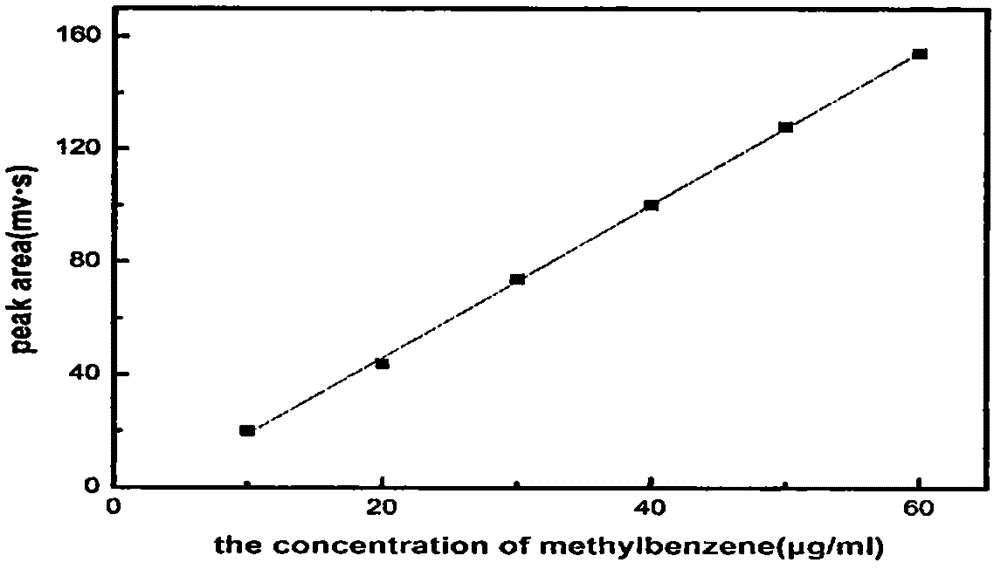New Timone massilia strain and application thereof
A technology of Marseilles and new strains, applied to new strains of Marseilles Timones, new strains of Marseilles Timones in the field of oil pollution bioremediation, can solve the problem of secondary pollution by chemical methods, and achieve the ability to reduce the surface tension of liquids , Good biosurfactant ability, good emulsifying activity
- Summary
- Abstract
- Description
- Claims
- Application Information
AI Technical Summary
Problems solved by technology
Method used
Image
Examples
Embodiment 1
[0019] 1) Collect the sediment from the dredging boat area of the Xiangjiang River as a sample, and store it in a refrigerator at 4°C. Weigh 30 g of the soil sample to be tested, put it into 100 ml of sterile water, and add 10 g of glass beads. Placed in a constant temperature shaker at 180 rpm and shaken for 30 min.
[0020] 2) After shaking, take out the triangular flask, let stand for 20min at room temperature, take 1ml of supernatant, and carry out a 10-fold serial gradient dilution to 10 under sterile conditions -7 , respectively take 10 -3 , 10 -5 , 10 -7 25 μL of the diluted bacterial suspension of three concentrations was coated on the yeast solid inorganic salt medium coated with toluene in advance, placed in a vacuum desiccator for 24 hours at room temperature, and the plate was inverted when there were no more water droplets on the surface of the plate.
[0021] 3) According to the growth time of the colony on the yeast medium and the difference in the form of...
Embodiment 2
[0028] Morphology and molecular biology research of J42 strain of the present invention.
[0029] The formula of the LB medium used in this example is: yeast extract 5.0g, peptone 10.0g, sodium chloride 10.0g, agar 15.0g, pH 7.2-7.4.
[0030] The J42 strain obtained by the present invention was inoculated on a LB solid medium plate, and was cultured upside down at 30° C. for 24 hours to observe its colony morphology.
[0031] The morphological characteristics of the new strain are: orange-yellow, round and convex, neat edges, smooth and moist surface.
[0032] Bacteria identification
[0033] Take 200 μL of sterile EP tube, add 50 μL of sterile double-distilled water to the tube, then take a small amount of the J42 bacterial strain obtained by the present invention and suspend it in the EP tube, and finally use a pipette to repeatedly suck the liquid in the EP tube to make the bacterial cells. Mix well to make bacterial suspension. The bacterial suspension was treated in a ...
Embodiment 3
[0038] Study on Surfactant Production Characteristics of Strains
[0039] The liquid culture medium formula used in this example is: carbonate buffer 1000mL, MgSO 4 ·7H 2 O0.1g, NH 4Cl 0.5g, Na 2 HPO 4 0.5g, CaCl 2 ·6H 2 O 0.01g, FeSO 4 .7H 2 O0.005g, toluene 5g, trace elements 1mL; the formula of trace elements is: ZnSO 4 ·7H 2 O 0.44g, CuSO 4 ·5H 2 O 0.20g, MnSO 4 ·2H 2 O0.17g, Na 2 MoO 4 ·2H 2 O 0.06g, H 3 BO 3 0.10g, CoCl 2 ·6H 2 O 0.08g, dilute to 1000mL with distilled water; the formula of carbonate buffer is: Na 2 CO 3 0.105g, NaHCO 3 0.756g, dilute to 1000mL with distilled water, pH 8.0.
[0040] Select the new strain B11 of petroleum degrading bacteria, inoculate it into the liquid medium, and control the initial inoculation concentration to be 10 7 cells / mL, cultured in a constant temperature air bath shaker at 30°C and 180rpm for 5 days. Five days later, the bacterial culture solution was drawn to test the biosurfactant production ability. ...
PUM
 Login to View More
Login to View More Abstract
Description
Claims
Application Information
 Login to View More
Login to View More - Generate Ideas
- Intellectual Property
- Life Sciences
- Materials
- Tech Scout
- Unparalleled Data Quality
- Higher Quality Content
- 60% Fewer Hallucinations
Browse by: Latest US Patents, China's latest patents, Technical Efficacy Thesaurus, Application Domain, Technology Topic, Popular Technical Reports.
© 2025 PatSnap. All rights reserved.Legal|Privacy policy|Modern Slavery Act Transparency Statement|Sitemap|About US| Contact US: help@patsnap.com


